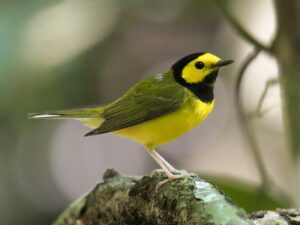Curiosity led me to wonder about our feathered friends’ behavior during rainy days.
Have you ever noticed that birds seem to disappear when it rains? Or perhaps you’ve wondered where they go and what they do to cope with the wet weather?
In this article, we’ll explore the fascinating world of birds and discover where they seek shelter and what strategies they employ when raindrops start to fall.
Let’s dive in and uncover the secrets of what happens to birds when it rains!
Where Do Birds Go When It Rains? and What Do Birds Do When It Rains?
Let’s have a look at some different species of birds and what they do when it rains.
1. Seabirds
The bigger seabirds can withstand oceanic and marine storms better than the smaller ones.
Smaller seabirds fly closer to the coast in search of protection.
They have a hard time flying during a storm because of their tiny size.
It’s possible that they’ll succumb to it.
If seabirds, which are normally located far from dry land, are sighted closer to the coast, it might be a sign of a coming storm.
It is simple for pelicans and gulls to navigate through a storm.
This action serves as a warning to other birds that a threat is approaching and that they should follow suit.
Preen glands sometimes called oil glands are oil glands found in seabirds.
Their feathers are waterproof because of this oil.
When a seabird seeks refuge during a rainstorm, it is usually often due to the severity of the weather, not the deluge itself.
2. Birds of the Land
The majority of birds are unconcerned with a little light pitter-patter.
This is due to the fact that birds have waterproof feathers, as previously stated.
The shiny coat is confirmation of this if you’ve ever touched a bird and looked at it up close.
Their preen glands generate an oil that keeps their feathers clean.
When it rains, land birds seek shelter in trees and shrubs.
You could have even observed birds gathered on your window ledge.
Furthermore, they remain rather still during rainstorms.
This is a strategy for conserving energy as much as feasible.
During mild and severe rains, there is an interesting distinction between birds and their behavior.
If it’s the first, their feathers will be fluffed up to keep them warm.
However, heavy rains cause them to flatten their feathers.
Birds may have low energy levels if the rains do not cease very soon.
Priorities alter at this point.
It becomes critical for them to eat, regardless of the circumstances.
3. Birds that Eat Seeds
The energy of birds depletes quickly.
This is why they must continue to eat.
Seed-eating birds may encounter an unusual challenge.
During the rainy season, birdseed might become wet, so even though there is plenty of food, wet birdseed is not advised.
When it’s raining, some birds may flock to birdfeeders with a shade or canopy attached to seek shelter.
4. Insectivores

During the wet season, the birds in this group have the worst luck.
Insectivores include birds like warblers and robins.
Because the weather makes their prey lethargic, these birds have a hard time obtaining food when it rains.
Furthermore, severe rains have the potential to wash away the insects they feed on, as well as murky waterways and muck.
Insectivores are unable to create body heat for a variety of reasons.
Insectivores eating on nectar or searching for insects stuck in the mud are not unusual sights.
Long periods of hunger can even kill certain birds.
5. Birds of the Water
When it rains, aquatic birds are reported to be overjoyed.
In a more practical sense, the rain makes it much simpler for them to obtain food.
Aquatic birds, like other birds, have a water-resistant coat.
As a result, they have no genuine need to be afraid of hypothermia.
When it comes to swans and ducks, they may dwell on both land and water.
One feature that distinguishes them from non-aquatic birds is that they are less prone to losing body heat.
Smaller birds, including ducklings, are particularly susceptible to rainstorms.
This is mostly due to the fact that they are younglings with feathers that lack the normal waterproof property.
6. Songbirds
Songbirds are extremely tiny birds.
From our discussion thus far, it is clear that songbirds fall into the category of birds that will suffer severe repercussions if they do not seek cover during rain.
Songbirds have been observed to seek shelter under leaves and in shrubs.
They don’t have an option except to save the limited amount of energy they have.
They do this by remaining motionless.
This is how they hibernate during long rainstorms.
7. Raptors
A raptor is a bird that hunts and kills other animals.
Drizzling and light showers but little in the way of raptors in their search for food.
They do, however, have difficulty during monsoon season and periods of heavy downpours.
During storms, they, too, must seek refuge.
As a result, they are unable to scavenge for food and therefore fulfill their hunger.
What Effects Do Rains Have on Birds?
Given their constant movement, you may believe birds are unconcerned by rain.
Rains can be a hindrance to these flying species, even though they appear to be constructed to endure the elements.
1. Hypothermia and Malnutrition
During the rainy season, all birds are vulnerable to cold and hunger.
For different birds, this two-pronged danger manifests itself in various ways.
Smaller birds have a harder time keeping their body heat.
They may shiver as a result of the constant rain.
Rains can also be harmful to raptors that feed on smaller animals like mice, rabbits, and gophers.
Because their prey hides during the rains, they face hunger.
2. Big Birds vs. Smaller Birds
Varied birds have different ways of defending themselves from the rain.
Before we get into the many types of birds and how they adjust to the rainy season, there’s one thing that virtually all of them have in common.
In comparison to their smaller, more fragile cousins, larger birds fare better in the rain.
Showers vs Storms
Storms and severe downpours are a significant source of concern, particularly for smaller birds.
While this is true, little birds have a secret edge when it comes to severe rainfall.
This is due to their ability to find refuge in even the tiniest of places.
These birds can readily maintain their body heat by keeping dry and sheltered.
When it’s raining, birds maintain their bodies upright and their beaks angled slightly upwards towards the sky.
This specific posture is beneficial to birds in two ways.
For starters, it allows them to save electricity.
Second, it reduces the likelihood of droplets adhering to their skin.
Even though larger birds are more robust, bad weather may be harmful to them at times.
Even if these birds continue to fly during storms, the rain might cause their vision to be disrupted and distorted.
This can result in unfavorable, even fatal, accidents with trees and high-rise structures.
Except for the smallest birds, showers, and drizzle pose no major harm to them.
Even yet, light rain does not continue long and does not have the same debilitating effect as a thunderstorm.
Surroundings
When it comes to surviving downpours, a bird’s immediate surroundings make a big impact.
If a bird is in a location with a lot of trees, it may easily locate a temporary home within tree holes, hedges, and branches that are shaded by a high canopy of leaves.
As they say, the possibilities are infinite.
When it comes to harvesting food, the environment, of course, plays an important role.
Smaller birds, in particular, must maintain a high level of energy.
If they don’t, they risk becoming stagnant.
There’s no need to be concerned if a bird is fortunate enough to be in such a location when thunder and lightning hit.
In particular, this is true if the sort of food it needs is easily available.
Only then they can wait for the storm to pass.
However, if only one of the two requirements is satisfied, birds will be forced to endure the storm and proceed in quest of food.
After all, once hunger hits, the value of being warm will fade.
Conclusion
In conclusion, the behavior of birds during rainy days is a testament to their remarkable adaptability and survival instincts.
While they may seem to disappear from our view, birds have clever strategies for coping with the rain and seeking shelter.
During light rains, many birds may continue their normal activities, such as foraging for food and preening, taking advantage of the milder conditions.
However, when the rain becomes heavier or is accompanied by strong winds, most birds will seek shelter in various ways.
Some birds find refuge in dense foliage, bushes, or trees, using their feathers to create a waterproof barrier that keeps them dry.
Others may take cover under building eaves, bridges, or other structures.
Certain species, like seabirds, may ride out the storm at sea, well-equipped to handle adverse weather conditions.
Interestingly, rain can bring about increased insect activity, providing a feast for insect-eating birds, even during or after the rain showers.
It’s essential to remember that disturbing birds during such times can be harmful, as they need to conserve energy and maintain their focus on survival.
So, observing them from a distance during rainy days is the best approach.
As nature’s avian experts, birds have evolved over time to face diverse weather challenges, including rain.
Their resilience and resourcefulness remind us of the marvels of the natural world and the wonders that surround us every day.
So, the next time you witness raindrops falling, take a moment to appreciate the unseen world of birds finding shelter and employing their clever strategies to brave the storm.
It’s a beautiful reminder of the interconnectedness of all living creatures and the incredible ways they adapt to the elements that shape their environment.
FAQ
Where do birds go when it rains?
When it rains, birds seek shelter to stay dry and protect themselves from the elements. They may take cover in dense foliage, trees, shrubs, or under building eaves and ledges. Some birds, like seabirds, may continue flying and find refuge over open water.
Do birds fly away during heavy rain?
While some birds may fly to find better shelter during heavy rain, many seek protection nearby. They are usually well-adapted to handle rain and will hunker down in secure locations until the rain subsides.
How do birds stay dry during rain?
Birds have specialized feathers that provide insulation and are treated with natural oils. They will often preen their feathers to maintain their waterproofing, preventing rainwater from reaching their skin.
Can birds get sick from rain?
Generally, birds do not get sick from rain. Their feathers and behaviors are designed to withstand wet conditions. However, extended exposure to cold and wet weather can be stressful, affecting their overall health.
Do birds eat during rainy days?
Yes, birds continue to eat during rainy days, especially if the rain is light. Rain can bring out more insects, making it a good time for insect-eating birds to find food. However, during heavy rain, birds may reduce their foraging activities and conserve energy.
How do nesting birds protect their nests during rain?
Nesting birds build their nests in sheltered locations to protect them from rain. The nest’s structure and the parents’ behavior, such as covering the nest with their bodies, help shield the eggs and chicks from getting wet.
Will bird feeders attract birds during rainy days?
Bird feeders can still attract birds during rainy days, especially when natural food sources become scarce. Providing a dry food source can be a great help to birds during wet weather.
Why do some birds bathe in rain puddles?
Rain puddles provide birds with a convenient water source for bathing and preening. Bathing helps them keep their feathers clean, which is essential for maintaining their insulation and waterproofing.
How long do birds stay sheltered during rainstorms?
The duration birds stay sheltered during rainstorms can vary. If it’s a passing shower, they may quickly resume their activities once it stops. However, during prolonged heavy rain or storms, they may remain in a shelter for more extended periods.
Are there certain bird species that are more active during rainy days?
Yes, insect-eating birds like robins, flycatchers, and swallows can become more active during rainy days since rain brings out insects that serve as a food source for these birds.
Last Updated on July 19, 2023 by Lily Aldrin

